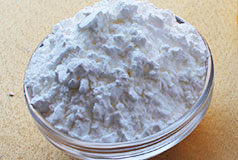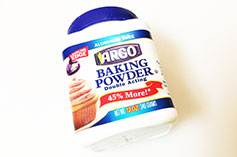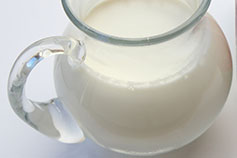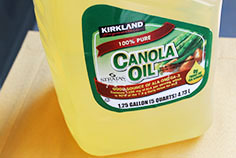
All-Purpose Flour
All-purpose flour is a kind of processed wheat flour that contains neither the germ (the sprouting part) nor the bran (the outer coating) of wheat. The wheat germ is replaced by niacin, riboflavin, thiamin and iron, and sometimes vitamins A and D are also added. That’s the reason; these flours are labeled as enriched.
All-purpose flour comes in two forms— unbleached and bleached. The flour that is bleached naturally as it ages is called unbleached. Bleached flour is chemically treated to accelerate the aging process and treated to improve its consistency and baking properties. Bleached flour is fine in texture and white in color and has less protein than unbleached flour, which is coarse and yellowish.
Bleached flour is best for making cookies, pound cakes, pancakes, pie crusts, and waffles while unbleached flour is suitable for making yeast breads, puddings, cream puffs, and popovers. Though both flours can be used interchangeably, the effect in texture and color would not be same.
Since, the germ and bran part is stripped away from the all purpose flour, its shelf life is longer. Store the flour in an airtight container and in a cool, dark, and dry place. You can store the flour at room temperature in your pantry for about one year. If you choose to refrigerate or freeze it, it will go for about two years.
All-purpose flour is easily available at any grocery store, or you can buy online at amazon.com. You can also explore other online resources for buying all-purpose flour.
All-purpose flour comes in two forms— unbleached and bleached. The flour that is bleached naturally as it ages is called unbleached. Bleached flour is chemically treated to accelerate the aging process and treated to improve its consistency and baking properties. Bleached flour is fine in texture and white in color and has less protein than unbleached flour, which is coarse and yellowish.
Bleached flour is best for making cookies, pound cakes, pancakes, pie crusts, and waffles while unbleached flour is suitable for making yeast breads, puddings, cream puffs, and popovers. Though both flours can be used interchangeably, the effect in texture and color would not be same.
Since, the germ and bran part is stripped away from the all purpose flour, its shelf life is longer. Store the flour in an airtight container and in a cool, dark, and dry place. You can store the flour at room temperature in your pantry for about one year. If you choose to refrigerate or freeze it, it will go for about two years.
All-purpose flour is easily available at any grocery store, or you can buy online at amazon.com. You can also explore other online resources for buying all-purpose flour.

Baking Powder
Coming Soon...

Sugar
Coming Soon...

Whole Milk
Whole milk is least adulterated and is very much similar to the way it comes from cow or other dairy farm animals. It is intact and the components like fat and water are not removed. It contains 3.4% fat and 87% water in addition to proteins and enzymes, vitamins and minerals, and carbohydrates.
The flavor of fresh milk is balanced and mild. The lactose in the milk makes it sweet and the minerals make it slightly salty and very slightly acidic. Its mild and pleasant aroma is due short-chain fatty acids that keep the highly saturated milk fat fluid at room temperature, and the short-chain fatty acids reach our nose when evaporated.
The basic flavor of milk is affected by the animals’ feed and microbial activity in the cow’s rumen (first part of stomach). Pasteurization also slightly modifies the fresh flavor of milk. Flavor of milk deteriorates due to oxidation by contact with oxygen or exposure to strong light.
Milk is a rich source of many essential body-building nutrients, particularly proteins, sugars, and fat, vitamin A and B vitamins, and calcium. It is always safe to buy milk with USDA Organic seal to make sure that the dairy farm animal is not treated with drugs including growth hormones. The animals are allowed to gaze and fed organic fodder.
The flavor of fresh milk is balanced and mild. The lactose in the milk makes it sweet and the minerals make it slightly salty and very slightly acidic. Its mild and pleasant aroma is due short-chain fatty acids that keep the highly saturated milk fat fluid at room temperature, and the short-chain fatty acids reach our nose when evaporated.
The basic flavor of milk is affected by the animals’ feed and microbial activity in the cow’s rumen (first part of stomach). Pasteurization also slightly modifies the fresh flavor of milk. Flavor of milk deteriorates due to oxidation by contact with oxygen or exposure to strong light.
Milk is a rich source of many essential body-building nutrients, particularly proteins, sugars, and fat, vitamin A and B vitamins, and calcium. It is always safe to buy milk with USDA Organic seal to make sure that the dairy farm animal is not treated with drugs including growth hormones. The animals are allowed to gaze and fed organic fodder.

Canola Oil
Coming Soon...

Vanilla Extract
Coming Soon...

Egg
Coming Soon...

Non-stick Oven Spray
Coming Soon...
Share your thoughts and questions!


